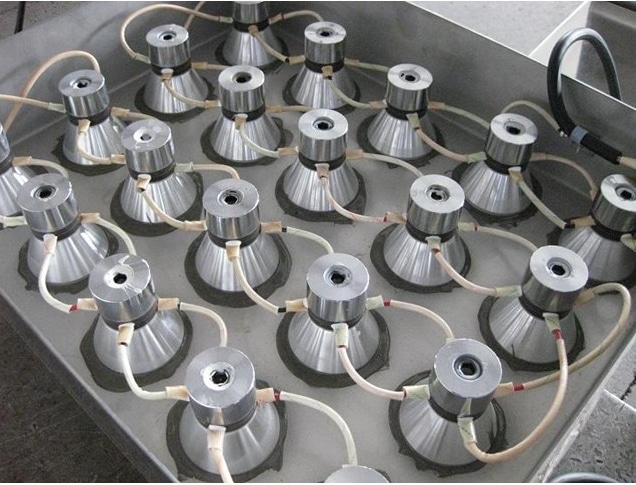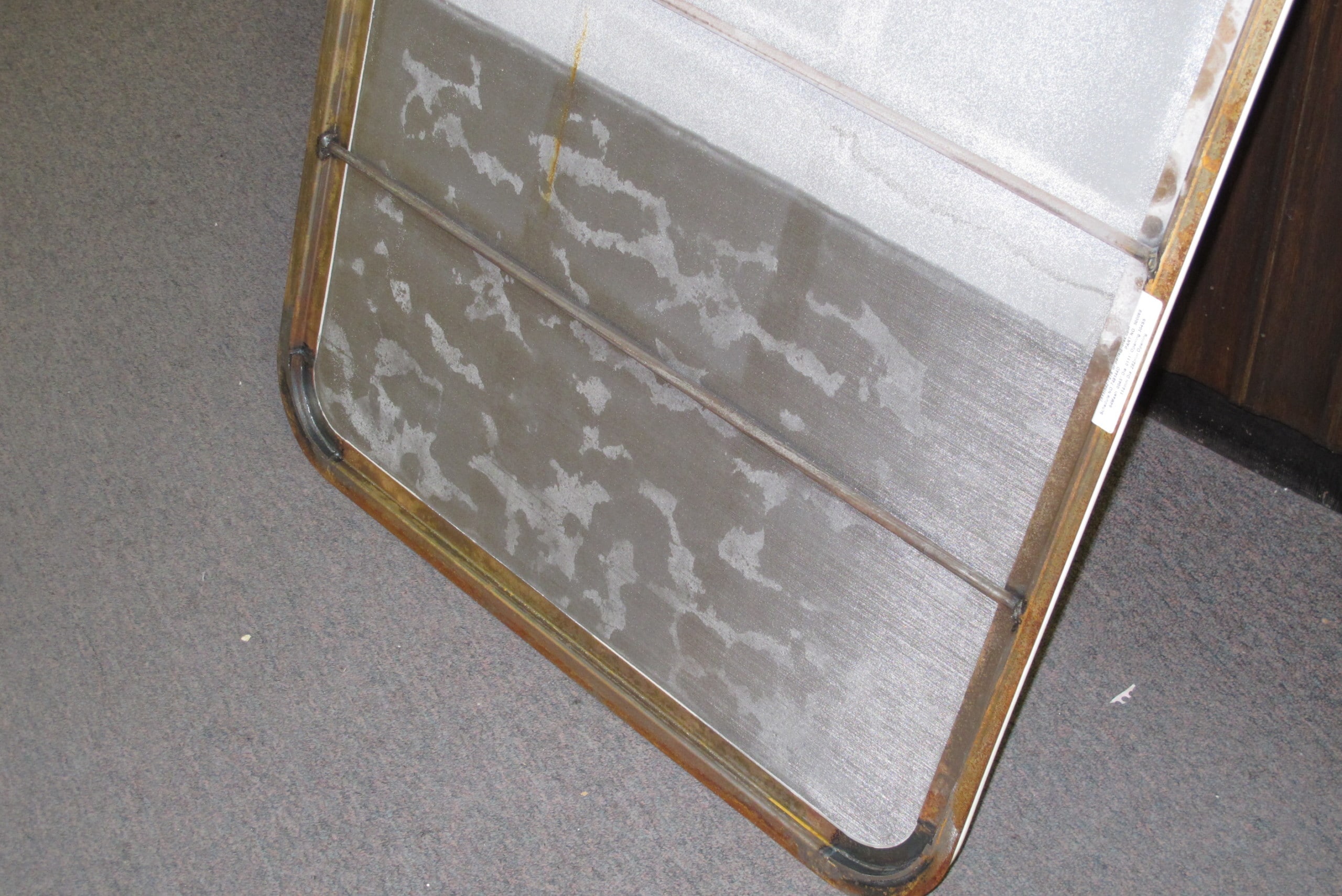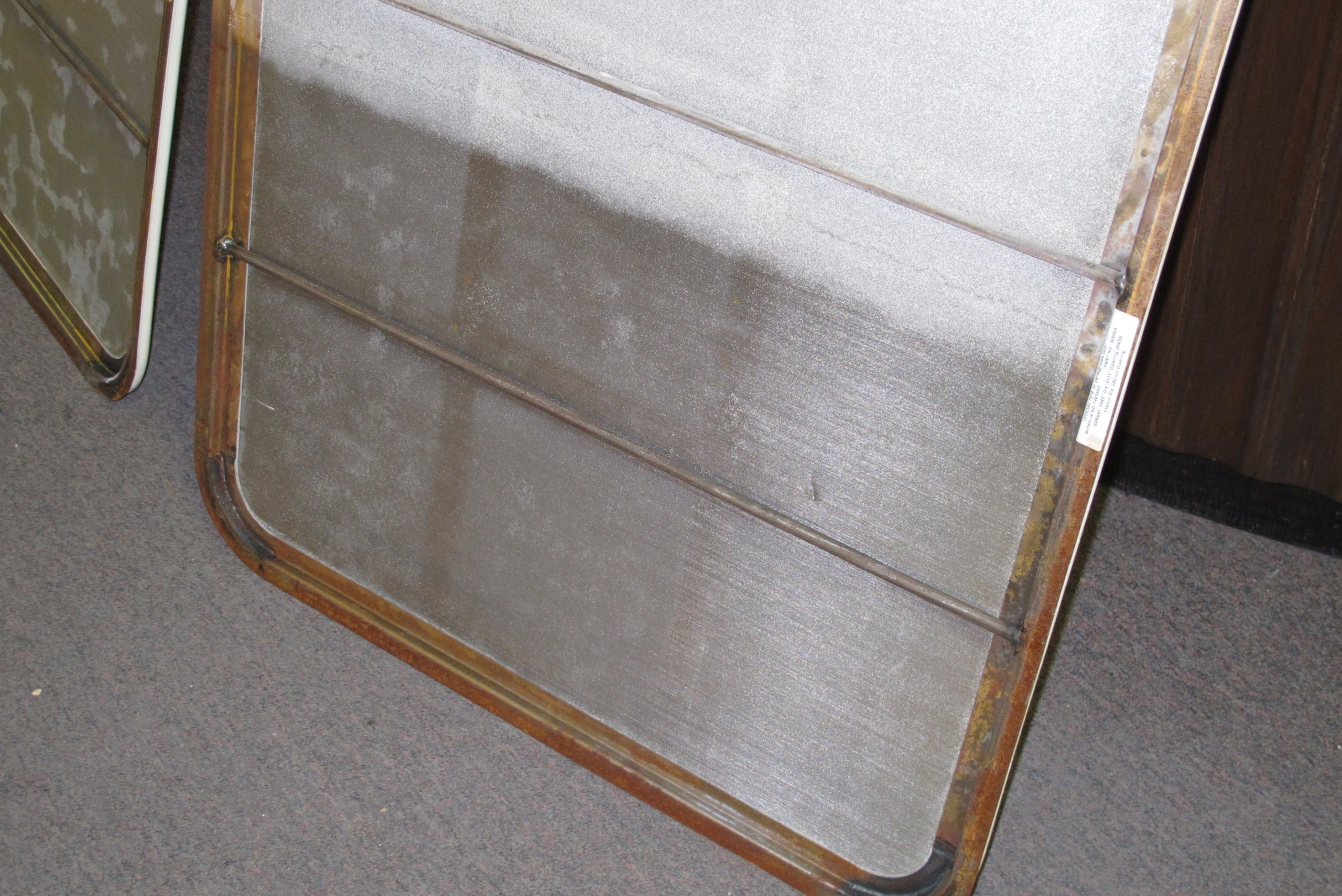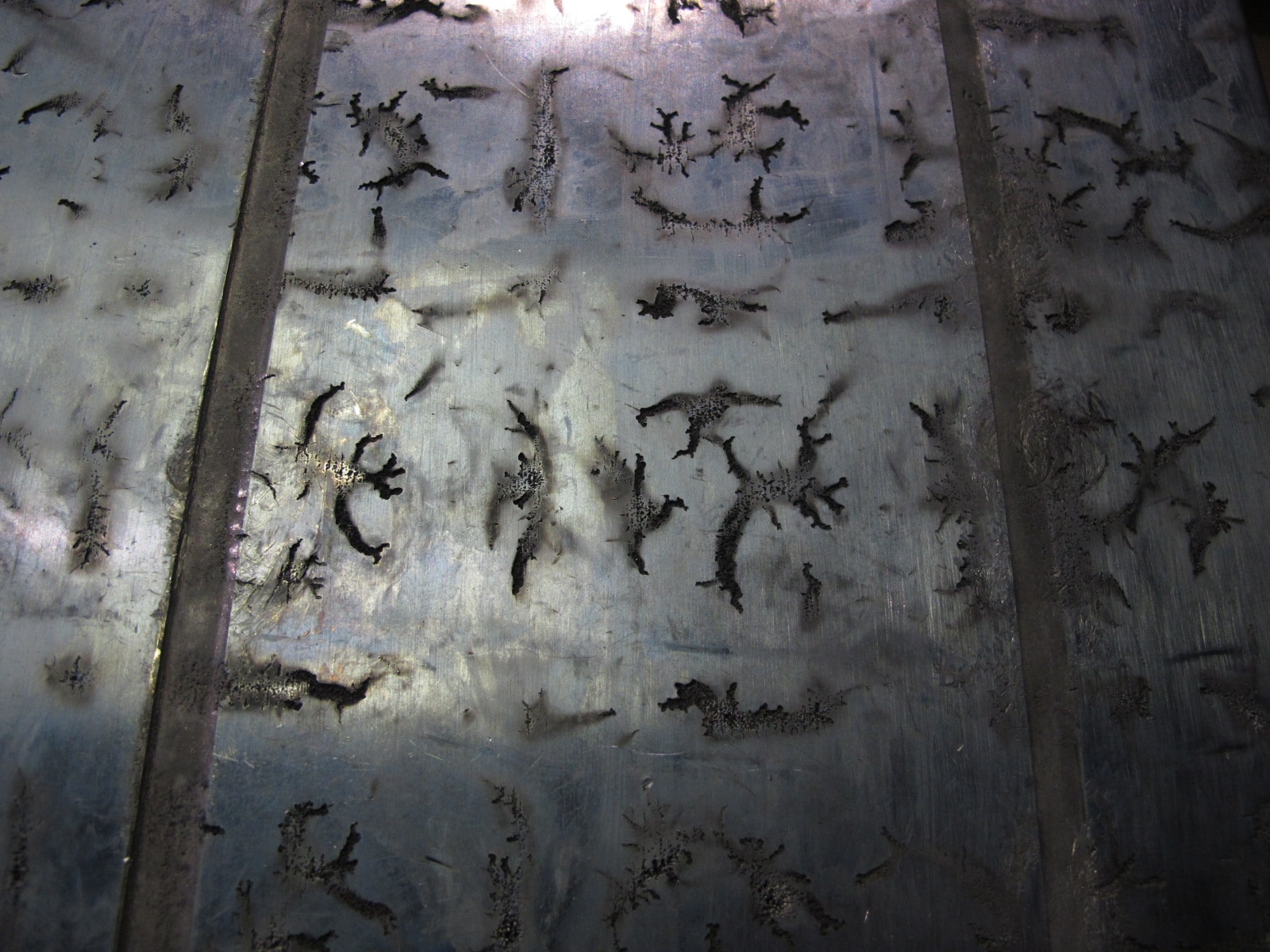Transducer Types Used in Ultrasonic Cleaning Systems
All ultrasonic cleaning systems utilize 1 of 2 available transducer types; piezoelectric transducers and magnetostrictive transducers. There are many differences between these transducer designs, including the way in which they are bonded to the “radiating surface” or ultrasonic diaphragm, the frequencies which can be generated, and the electrical efficiency of the system. We will discuss each difference in detail.
How each transducer design functions
Both transducer designs produce ultrasonic activity by rapidly oscillating the ultrasonic diaphragm to which they are mounted. However, each design performs this action differently. Magnetostrictive transducers are essentially electromagnets made of a heavy nickel or alloy core which is wound with wire. As electrical current is pulsed through the wires, the core vibrates at a frequency which matches the output frequency of the ultrasonic generator, thereby producing the ultrasonic cleaning effect in the tank.
This is the oldest ultrasonic transducer technology known, and was used prior to the development of efficient and powerful piezoelectric transducers which offered 95% + electrical efficiency when compared to the 50-60% electrical efficiency of magnetostrictive transducers. This efficiency difference still exists today, and is the one of the reasons why 98% of ultrasonic equipment manufacturers use piezoelectric transducers.
Piezoelectric transducers are manufactured of lead zirconate titanate, a common piezoelectric material which expands and contracts when provided with the appropriate electrical frequency and voltage. As the transducer expands and contracts rapidly, the ultrasonic diaphragm vibrates to introduce ultrasonic activity into the cleaning tank. This design represents the most efficient design currently available.
How are transducers bonded to the radiating surface?
Most manufacturers of piezoelectric ultrasonic systems use high-temperature epoxy to attach the transducers to its radiating surface. Zenith bonds its transducers using a metallurgical stud, and uses epoxy to prevent the ROTATION of the transducer off of this stud, leading a significantly greater bond strength than when using epoxy alone. In fact, if you used a hammer and attempted to break one of our transducers off of the tank, you would rip a hole in the tank rather than detaching the transducer!
Magnetostrictive transducers are bonded using vacuum brazing of the transducer base to the ultrasonic diaphragm.
Manufacturers of magnetostrictive ultrasonic designs are quick to point out that a vacuum-brazed transducer bond is superior to an epoxy-bonded transducer. This may be the case when dealing with Zenith competitors, but it is NOT the case when comparing to Zenith’s transducer bonding system. Epoxy-bonded transducers without the metallurgic stud cannot withstand highly abusive environments, such as environments in which objects may be dropped onto the diaphragm which may cause damage to the epoxy bond. However, these environments do not exist in 99% of ultrasonic cleaning operations. Additionally, transducers can easily be protected against such damage.
How efficient are magnetostrictive and piezoelectric transducers?
Ultrasonic cleaning systems operate by converting electrical energy into mechanical vibration to produce ultrasonic cavitation in the cleaning fluid. When an ultrasonic system is highly-efficient, most of the incoming electrical power is converted to mechanical vibration. For example, piezoelectric ultrasonic cleaning systems manufactured at Zenith are 95-98% electrically efficient. Most of the in-coming power is being converted into mechanical vibration. This efficiency is common to most piezoelectric ultrasonic systems, and is one of the primary reasons why over 95% of all ultrasonic equipment manufacturers utilize piezoelectric transducers.
Magnetostrictive transducers are highly in-efficient in design. More electrical power will be required to generate the same amount of ultrasonic cleaning action as a comparable piezoelectric system. Not only do these systems require more electrical current, but the generators are also very large, and may require air-conditioning or other special cooling methods to keep components within acceptable operating temperatures. As mentioned earlier, this is a very old technology that is being marketed as something new. Electromagnets are not new technology.
The lack of electrical efficiency is one of the main reasons why magnetostrictive systems are rated for such high wattages, but purchasers must know that these ratings represent INPUT wattage, not OUTPUT wattage in the tank. For example, if a magnetostrictive transducer system is rated for 1000 watts, the power in the tank will be only 500-600 watts due to electrical inefficiency.
Which frequencies are available for each transducer type?
Ultrasonic operating frequency is perhaps the single most important consideration when choosing an ultrasonic cleaning system. Each frequency has its own unique characteristics. Low frequencies are used for large, un-detailed parts with heavy contamination and produce un-even cleaning action in the fluid, while higher frequencies produce more evenly-distributed cleaning action, and have the ability to penetrate small blind holes, threaded areas, and other detail.
Choosing an ultrasonic frequency for a magnetostrictive system is easy, since there really is no choice at all. Magnetostrictive system designs typically operate at frequencies below 30kHz, making these systems unsuitable for most ultrasonic cleaning applications. Most parts being cleaned ultrasonically require the removal of lightly-bonded contaminants on the surface of precision parts, applications which are addressed with 40kHz, 80kHz or CROSSFIRE Multiple Frequency Ultrasonics operating in this range. Low frequencies would produce inconsistent cleaning results on such parts, and parts may be damaged by cavitational erosion.
To get an idea of the type of scrubbing action produced by low-frequency systems, take a look at the top photo at the right. This screen was cleaned in a 25kHz ultrasonic system. Note the spotty cleaning results created by the large areas of lower ultrasonic power produced in a low frequency system. There are areas of high lower, and areas of lower power, and the contaminant in this example could not be removed in the lower power areas of the ultrasonic cleaning tank. Parts being cleaned in lower frequency systems will obtain different levels of ultrasonic power depending upon where they happen to rest in the ultrasonic cleaning tank.
The lower photo depicts an identical sample cleaned in the same cleaning fluid with Zenith’s CROSSFIRE 40/80kHz ultrasonic system. The even energy distribution created by the combination of 40kHz and 80kHz ultrasonics produces a much more evenly distributed cleaning effect, and results in consistent and even cleaning regardless of part position in the tank.
Although Zenith manufactures 25kHz ultrasonic systems, they are rarely recommended for any ultrasonic cleaning applications, unless they are combined with 40kHz in a CROSSFIRE system. This is the direct result of the thousands of sample parts which have been test-cleaned ultrasonically at Zenith. Our Ultrasonic Testing Service is used to develop complete processes for our potential customers. Parts are submitted and tested in various ultrasonic frequencies and cleaning agents to determine the best process to use for a given application. Low frequency ultrasonic cleaning systems in the 25kHz-30kHz range never produce a better cleaning result than higher frequency systems do. In fact, it is exactly the opposite. Parts are cleaned more effectively in systems operating at 40kHz and above. Since these systems are less damaging to components, quieter in operation, and better at cleaning in fine detailed areas, these systems are usually recommended for any cleaning application.
How reliable are magnetostrictive and piezoelectric transducers
Magnetostrictive ultrasonic generators operate at such high temperatures that it is common for these systems to require extensive additional cooling, such as air conditioning equipment dedicated to cooling the generators. This excessive heat may cause premature failure of certain components in the system. To overcome these issues, most manufacturers of magnetostrictive systems utilize more expensive, large electronic components which are able to withstand these high operating temperatures, and generator enclosures are significantly larger as a result.
Piezoelectric cleaning systems are highly-reliable electronic devices when properly engineered. If they weren’t, no one would buy them, and 98% of ultrasonic cleaner manufacturers would not use them. Generators are manufactured using surface mounted devices, transistors, and common MOSFET components, and run cool when compared to a magnetostrictive design. Generators are relatively small, lightweight, and do not require air conditioning or excessive cooling.
With regards to transducer reliability, piezoelectric transducers are in use for decades, and contrary to the claims of the 2% of the manufacturers that utilize these transducers, they are highly reliable. This is why manufacturers of piezoelectric systems such as Zenith Ultrasonics include a 10 year transducer bond warrantee. We could not offer such a warrantee unless we were very sure of the bond reliability.
Long-term operational reliability and power of piezoelectric transducers has been questioned by manufacturers of magnetostrictive ultrasonic systems, which claim that transducers lose power over time, and continuously deteriorate internally. Zenith has not found this to be the case, and has over 79 years of experience proving otherwise. Zenith performs repairs on piezoelectric systems which have been in operation for 20-30 years. These systems have perfect transducer bonds that have not deteriorated, and the cleaning power is just as good or better than when originally installed, leading one to conclude that piezoelectric transducer systems, when properly engineered, can last for decades depending upon the application.
What is cavitational erosion and how do different transducer types affect it?
Since magnetostrictive ultrasonic systems operate at very low ultrasonic frequencies, the cavitational erosion created by such systems is much greater than that of higher ultrasonic frequencies. Cavitational erosion is the deterioration of the transducer diaphragm, and is normal for all ultrasonic cleaning systems. Over time, the ultrasonic diaphragm will slowly erode, and will eventually deteriorate to the point where replacement is required. The lower the operational frequency of the system, the faster erosion will occur, and since magnetostrictive transducers operate at low frequencies, one can expect significant erosion of the ultrasonic diaphragm.
To overcome this limitation, magnetostrictive system manufacturers construct their radiating diaphragms from very thick materials which extends the life of these systems. However, by increasing the thickness of the diaphragm, it also becomes less flexible as well, and reduces the effective cleaning power in the ultrasonic tank. The radiating diaphragm must be flexible enough to produce compression/expansion cycles in the cleaning fluid, a task which requires enormous power with diaphragms which are 3/8″ thick.
Piezoelectric ultrasonic systems utilize thinner radiating diaphragms to maximize the ultrasonic power and energy distribution in the cleaning tank. To overcome excessive erosion, Zenith applies specialized coatings to the radiating surface to decrease the rate of erosion/ Cavitational erosion is a direct indicator of ultrasonic power being generated. If your diaphragm is not eroding, there is not enough power on the diaphragm to damage the surface.
After reading the information above about transducer types, one can see why most ultrasonic equipment manufacturers choose piezoelectric transducers. While magnetostrictive designs are not damaged by shock, this is easily overcome by the use of protection devices mounted in the tank. Piezoelectric systems are superior in every other regard, including frequency selection, energy distribution in the tank, decibel levels generated, reliability, equipment size, and efficiency.





